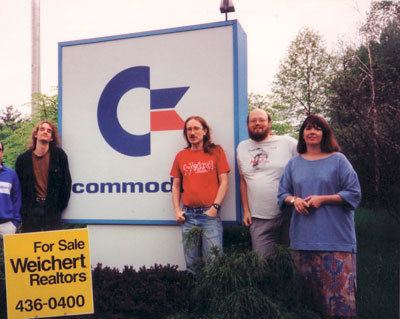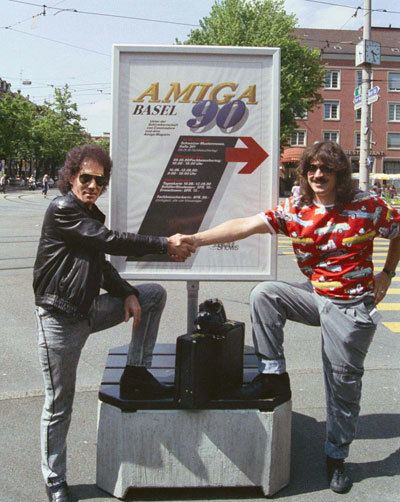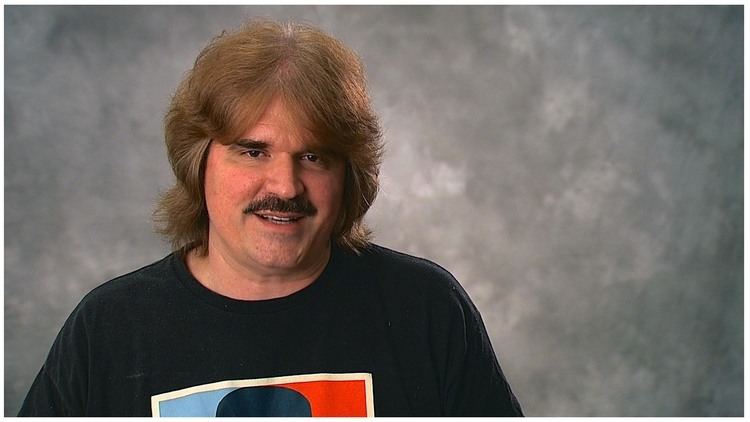Name Dave Haynie | Role Software Engineer | |
 | ||
Commodore Amiga: The Rise and Fall with Dave Haynie - The Retro Hour EP72
Dave Haynie is the former Commodore International chief engineer on high end and advanced projects. He is still quite vocal in the Amiga community.
Contents
- Commodore Amiga The Rise and Fall with Dave Haynie The Retro Hour EP72
- Vcf east 9 1 dave haynie commodore part 3 the amiga years
- Beginnings
- The Commodore years
- That first startup
- The set top revolution
- Fortele
- Robots and radios
- References

Vcf east 9 1 dave haynie commodore part 3 the amiga years
Beginnings

Dave was born David Bruce Haynie on May 23, 1961 in Summit, New Jersey, United States. He moved to Colts Neck, New Jersey in 1966 where he lived out his childhood with his three younger sisters. A few early Heathkit projects and, at the age of 12, a run-in with his dad's borrowed HP desktop calculator changed his life forever. From 12 years on, he taught himself programming, initially on timeshare systems from his dad's account at Bell Laboratories. Later on he wrote programs on his best friend Scott Scherer's Commodore PET 2001, the first home computer he had seen up close.

He left for college at Carnegie Mellon University in 1979. Four years later he graduated with a double BS in Electrical Engineering and Mathematics.
The Commodore years

He started work at Commodore in 1983 as an engineer under Bil Herd. His first project was to help complete the TED systems comprising Plus/4, C16 and more. After completing the Commodore 128 Bil Herd left the company and Dave Haynie was promoted to chief engineer in the low-end group. After Commodore acquired Amiga, Dave Haynie ended up primary engineer on the expandable A2000 computer. Later, he joined Bob Welland on the A2620 CPU module, and launched the follow-up A2630 the year thereafter. These were delivered in the A2500/20 (1989) and A2500/30 (1989).
In 1989 he started designing the Zorro III expansion bus architecture, and in 1990, with Greg Berlin, Hedley Davis, Jeff Boyer, and Scott Hood, created the Amiga 3000.
On completing the A3000 he was transferred to advanced projects, working with Bob Raible on the "AA" system (formerly "Pandora"), Commodore's first full 24-bit color computer technology, which led to the A3000+ prototype, and ultimately to A4000 and A1200 computers, Commodore's last commercial efforts. He also worked on a system for the Advanced Amiga Architecture chipset, a highly aggressive 64-bit graphic chipset started in 1993. He defined a new system architecture for this, the Acutiator project.
Most of this work, as most of the practical work at Commodore, was terminated by the end of 1993 due to financial problems within Commodore. Dave Haynie left Commodore in June 1994, over a month after the bankruptcy, for Scala, Inc. He made a two-hour film of the last days of Commodore, from the West Chester Engineer's perspective, released in 1994, called The Deathbed Vigil and other tales of digital angst.
That first startup
Driven in part by the experiences of his friends at Amiga, he joined Scala, Inc. The goal here was to advance some desktop presentation technology for use on other platforms. Dave's ability to switch-hit hardware and software was useful; Scala planned a hardware project, but not initially. He designed Scala's "Class Definition Language" and compiler, some high level tools for the operating system Scala was defining for portable multimedia. But the hardware projects never came around.
In 1995, Haynie did some consulting, along with Andy Finkel, for Amiga Technologies, the company resulting from Escom's acquisition of the Commodore assets. He and Finkel defined a next generation Amiga platform, based on a $500 PowerPC platform and a whole new version of AmigaOS. However, ESCOM's own financial problems killed this before it went very far.
The set-top revolution
The Amiga Technologies experience, however, wasn't for naught. Some of the managers liked what they saw in Haynie and Finkel. In June 1996 he joined managers Stefan Domeyer and Geerd Ebeling a German startup company initially called PIOS Computer, later renamed to Metabox. Metabox was initially selling Apple Macintosh clones and attempting to sell Amiga follow-on systems based on the PowerPC processor. An attempt to get a license to AmigaOS failed. Instead the company sold BeOS to Apple Macintosh clones and BeBox to the German market. Thanks to a lucky hire of Thomas Rudloff, an Amiga/Macintosh CPU board wizard, Metabox shipped the first commercial Macintosh-compatible system to run at 300 MHz.
After Steve Jobs shut down Macintosh compatibles, Metabox went in a different direction: the advanced set-top box. The first effort, the Metabox 100, simply enabled users to cheaply access Metabox's ISP service -- kind of a German WebTV. The follow up Metabox 500 was one of the first multimedia STB's around, adding video and high quality audio.
The big plan, however, was for the Metabox 1000, a ground up new design in hardware and software. This system used a smallish 90 MHz Coldfire as the main processor, but allowed all kinds of modular upgrades: for video, for DTV, for encryption. It tuned analog TV, DVB, played DVD, MP3, accessed network resources, did fully functional Web browsing and email, etc. In short, one of the first multi-function STBs. The home grown system design was enhanced by an AmigaOS-like operating system designed by Andy Finkel and Carsten Schlote. This system won much praise from Metabox's targets (large cable and satellite companies), but the company started failing. This was due to both the bad financial climate of 2000-2001, rumors of fraud and other monkey business, and German local law which was forcing the company to stop paying the development team (many consultants and non-Germans), while they kept the local people (at their peak, Metabox employed about 260 people). Haynie was quoted as saying, at their peak, his shares were worth about US$5.6million (sales were locked out from the IPO); but by the time he left the company, they owed him US$75,000, which was never repaid.
Fortele
After Metabox, Dave did a number of consulting gigs. Some paid well, some didn't pay, and none of it was terribly exciting. In 2002 he got back together with Andy Finkel and two other ex-Commodore people, Robert Russell and Neil Harris, to form Fortele, Inc. The plan here was whole house media networking. Their approach was to make every audio/video appliance just a node on the network, make the system know the user and learn his habits, etc. But despite the technology working well, the business part failed even before the dog and pony show had been finished.
Robots and radios
After Fortele, Haynie started working for Nomadio, Inc. Nomadio, Inc. is founded by Bhana Grover and Alex Gizis, both veterans of 1990s Internet startups. Haynie was initially hired on to work on a fullrobot project. However, Nomadio decided it was better to create a radio platform that would control radio control cars. Nomadio had released the first all-digital controller for high performance radio-controlled cars. At the same time Nomadio began producing harden version of digital controller for military robots.
Dave Haynie has also started an engineering and multimedia company called Frog Pond Media, which has served to indulge his love of digital audio and video studio work, and fill in the gaps between startup companies.
